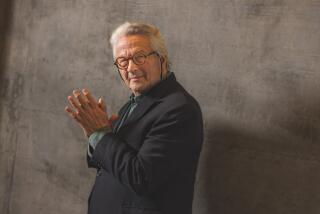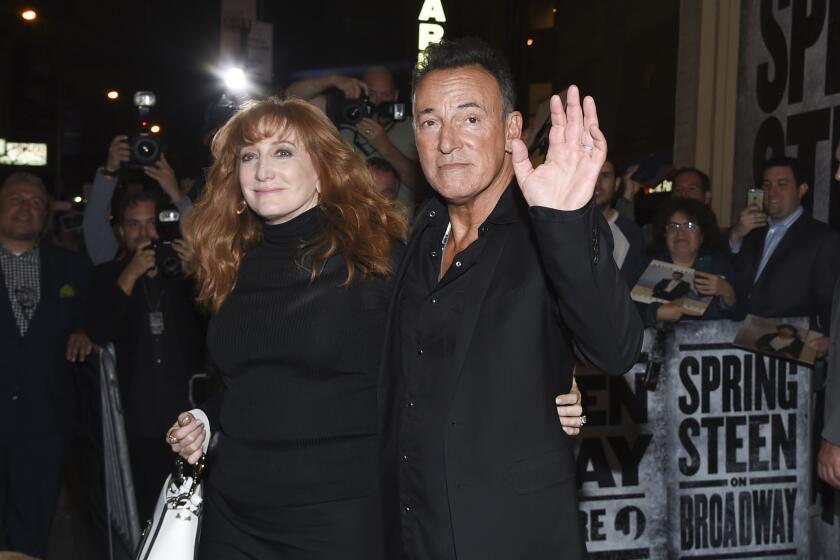Andre de Toth; Director’s Director Known for 3-D ‘House of Wax’
Andre de Toth, independent in-your-face director, writer and producer who created classic Westerns, film noir and arguably the best 3-D movie ever made, “The House of Wax,” has died. He was believed to be 89, although references to his birth year vary from 1910 to 1913.
De Toth, an adventurer throughout his colorful life, died Sunday of an aneurysm in his Burbank home.
Perhaps better known to film buffs than the public at large, he was one of the last of the European-trained filmmakers who came to the United States during World War II and made American genres his own. In recent years, he had enjoyed a renewed popularity at film festivals from Scotland to San Francisco and was greatly admired by contemporary directors, including Quentin Tarantino and Martin Scorsese.
De Toth, who shared an Oscar nomination in 1950 for writing the original story for “The Gunfighter” starring Gregory Peck, made about three dozen Hollywood movies. Among them were cult favorites, including 1944’s “None Shall Escape,” which predicted the winner of World War II and the Nuremberg trials for Nazis to come.
De Toth directed such films noir as 1948’s “Pitfall,” which he co-wrote, starring Dick Powell, Jane Wyatt, Lizabeth Scott and Raymond Burr, and “Crime Wave” with Sterling Hayden, Gene Nelson and Phyllis Kirk.
The director also created memorable Westerns, including “Ramrod” starring Joel McCrea and Veronica Lake -- to whom De Toth was married from 1944 to 1952 -- “Springfield Rifle” with Gary Cooper, “The Indian Fighter” with Kirk Douglas, and half a dozen films with Randolph Scott: “Man in the Saddle,” “Carson City,” “The Stranger Wore a Gun,” “Thunder Over the Plains,” “Riding Shotgun” and “The Bounty Hunter.” For television, De Toth directed episodes of “Maverick” and “The Westerner.”
But he will always be remembered for 1953’s “House of Wax.” The movie launched Vincent Price into his horror film career and is still regarded as the best of the three-dimensional lot, which required viewers to wear special cardboard-framed Polaroid glasses.
Unlike other directors playing with the new trick, De Toth stressed character and plot over the special effects: Price was a sculptor rebuilding his fire-destroyed collection by making statues out of his murder victims.
“Till now,” De Toth told The Times when he was making the film, “we have had only mental and emotional contact with you, the audience. Now we have physical contact. Not only can we reach out and touch you, but we will be able to reach your nerve centers through your eyes -- give your stomach butterflies, make you recoil, set your ticker pumping!”
De Toth remained enthusiastic about 3-D long after its demise, and was delighted when modern Imax techniques began re-creating the effects. His own accomplishment was considered all the more remarkable because he had lost an eye in his youth, destroying his depth perception and therefore his ability to see the girl from his film catapult into viewers’ laps after her trapeze broke.
Born Sasvrai Farkasfalvi Tothfalusi Toth Endre Antal Mihaly in Mako, Hungary, the filmmaker had his first exhibit of paintings and sculpture at age 14 and saw his first play produced at age 18. He studied law at the University of Budapest but also began acting, writing and working as a cameraman for cinematographer Istvan Eiben.
De Toth was soon entrenched in the Hungarian film industry, writing and directing. As war clouds gathered, he was forced to make propaganda films for the Nazis, including recording their invasion of Poland. In 1939, he went to England, where he worked as a second unit director for Alexander Korda on “The Thief of Bagdad” and other films.
De Toth immigrated to Hollywood in 1942, and worked with Korda on “The Jungle Book” and several other films. He made his own Hollywood directing debut with the 1943 “Passport to Suez.”
Still considered an enfant terrible in his 80s, he was forever pushing film codes with his frank depictions of violence and human emotions. “Life is violent,” he said simply in an interview with L.A. Weekly earlier this year. “To depict it truthfully can show us what not to do. Make us look at our ugly faces in the mirror.”
Asked a few years ago about his memorable “Gunfighter,” De Toth said he co-wrote the story to show “that gunfighters were stupid. Killing is ridiculous; nature takes care of death. We don’t have to help it.”
Scorsese, interviewed in 1994 when several De Toth films were shown at the Edinburgh Film Festival in Scotland, called him “a director’s director” and said: “There is tension in De Toth’s visual style that seems to reflect a continuous struggle between people and their surroundings. Be it in his film noir or his Westerns, De Toth’s characters always move in a treacherous world where deception and cynicism are aimed at one goal: survival.”
De Toth put his own life in danger frequently -- flying planes, racing cars, frequenting war zones -- as he detailed in his 1994 autobiography, “Fragments: Portraits From the Inside,” and a 1996 interview book, “De Toth on De Toth.”
Scouting for locations in Egypt shortly after the 1973 Yom Kippur War, he related, he was mistaken for Moshe Dayan and kidnapped, pistol-whipped and questioned by vengeful youths. He recounted other scrapes, including blundering into a student demonstration in his teens in Budapest, where he said he was shot and woke up in the morgue; getting trapped with Korda in a cage with a tiger named Rajah; and flying his own plane to an emergency landing in a snowstorm with the radio on fire.
Living, De Toth believed strongly, made one a better writer and director. Eschewing film school graduates making movies today, he wrote: “If they haven’t lived much, it’s their loss. Film schools teach you absolutely nothing: The psychology of being a director, it’s not mechanics -- either you’ve got it or you ain’t. The No. 1 requirement is understanding. A film director works with the most sensitive instrument: human beings. Being exposed to life makes you more understanding of the problems of people.”
De Toth also wrote about marrying seven women, including Lake, with whom he went through bankruptcy in Los Angeles courts, and having 19 children, including some stepchildren he adopted. He is survived by his wife, Ann Green, and several of his children.
More to Read
Only good movies
Get the Indie Focus newsletter, Mark Olsen's weekly guide to the world of cinema.
You may occasionally receive promotional content from the Los Angeles Times.










